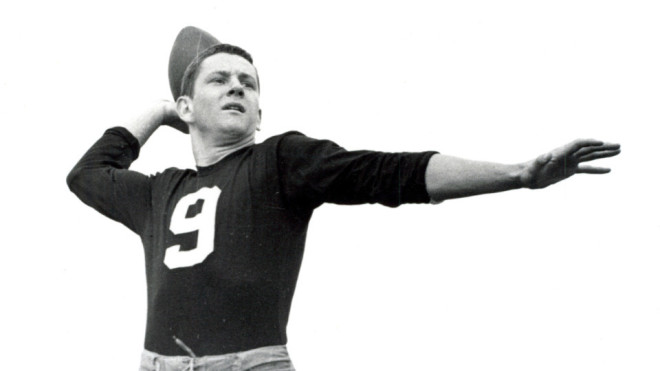Remembering Notre Dame Great Bob Williams

Lost in the news of the present and future is funeral services are being held today for one of the great quarterbacks and heroes from Notre Dame’s past, Bob Williams.
Then again, Williams, who died May 26 age 86 at his Mercy Ridge retirement home in Timonium, Md., was at ease with the lack of fanfare. Even though he was enshrined into the College Football Hall of Fame in 1988 for his role that helped Notre Dame capture the national title in 1949 — the school’s third in four years while building a 39-game unbeaten streak — he often was in the shadows.
Williams’ predecessors in the 1940s, Angelo Bertelli and John Lujack, won the Heisman Trophy in 1943 and 1947, respectively. Williams finished “only” fifth as a junior, with teammate and senior end Leon Hart winning the honor.
Quarterback successor Ralph Guglielmi won more often as a three-year starter who was also unbeaten as a junior, and another Notre Dame Heisman winner soon thereafter in Paul Hornung (1956) was more glamorous.
There was even another Bob Williams who succeeded Hornung as the starting quarterback at Notre Dame in 1957-58, highlighted by ending Oklahoma’s NCAA record 47-game winning streak in 1957.
Nevertheless, The First Bob Williams had his name arise a couple of times in recent years when noting special feats in Notre Dame football history.
First, Williams’ pass efficiency rating of 161.37 during the 1949 national title season when the Irish finished 10-0 was the single season school standard for a remarkable 60 years. It was finally broken by Jimmy Clausen in 2009 during a 6-6 campaign with a 161.42. The Notre Dame record book actually shows both at 161.4 when rounded off, but Clausen gets the nod by the slightest percentage points. In third place is Brady Quinn's 158.4 mark in 2005, with 1964 Heisman Trophy winner John Huarte fourth at 155.1.
Williams completed 83 of his 147 attempts for a then school record 1,347 yards — also held for 15 years before getting shattered by Huarte — 16 touchdowns (no one else had more over 10 games until Quinn in 2005) and seven interceptions.
While Williams was battling some health issues during that 2009 season, we called him to ask about his thoughts about his amazing record finally having a chance to be broken.
“That’s about 50th on my list of things I think about these days,” he chuckled while expressing surprise that he still did hold the mark.
He recalled how while going 13-of-16 in a hard fought 34-21 win at Michigan State that year, his performance was deemed an “aerial circus.”
“That was considered a lot of passes in those days — and now 16 might be thrown in the first five minutes,” he said. “The game has changed so much.”
Second, Williams’ name arose in 2012 when sophomore Everett Golson won his first 10 starts at quarterback before the 42-14 loss to Alabama in the BCS Championship game. Williams still holds the school record by winning his first 11 starts at QB.
Williams was not one to bring attention to himself, stating instead his gratitude for a lot of the World War II veterans still on the team in 1949 for accepting him as a 19-year-old starter who capped the season with a game-winning march at SMU for a 27-20 win to capture the national title.
Scholarship cutbacks at Notre Dame (from 32 in a season to 18) that began in 1947 began to catch up in Williams’ senior season when the Irish fell to 4-4-1. Still, he was sixth in the Heisman balloting and the No. 2 overall pick in the 1951 NFL Draft.
After playing in 1951-52, he interrupted his pro career by serving as a pilot in the Korean War, although he did return to fulfill his three-year contract with the Chicago Bears in 1955.
“Pro football was a lot different then,” he said. “People worked in the offseason to supplement their salaries. I had a chance to continue playing with the Pittsburgh Steelers, but I was having a family at that time, and it wasn’t fair to go back and forth while my wife was raising the kids by herself.”
In 1952 he married his high school sweetheart Anita Galvin, who passed away in 1998. They settled back near his Baltimore hometown to raise six children. At age 34, he became the president of Harbor Savings and Loan in Towson, and it was a position he held until age 70 in 2000, when he decided to retire after getting merged into a larger bank. He also founded the Arundel Woods Construction Company in 1960, which he dissolved in 1996.
Williams' football career, though often in the shadows, weathered the test of time while becoming one of Notre Dame’s many great ones, on an off the field.